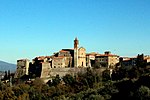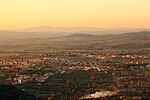Grilli, Gavorrano
Frazioni of GavorranoProvince of Grosseto geography stubs

Grilli is a village in Tuscany, central Italy, administratively a frazione of the comune of Gavorrano, province of Grosseto. At the time of the 2001 census its population amounted to 268.Grilli is about 25 km from Grosseto and 10 km from Gavorrano, and it is situated in a plain between the hills of Giuncarico, Caldana and Vetulonia. The village was born in the 19th century as an industrial centre related to the mines of Gavorrano.
Excerpt from the Wikipedia article Grilli, Gavorrano (License: CC BY-SA 3.0, Authors, Images).Grilli, Gavorrano
Via Grosseto,
Geographical coordinates (GPS) Address Phone number Nearby Places Show on map
Geographical coordinates (GPS)
| Latitude | Longitude |
|---|---|
| N 42.888333333333 ° | E 10.978055555556 ° |
Address
inCoop
Via Grosseto 68
58040
Tuscany, Italy
Open on Google Maps











